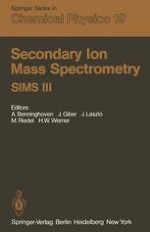1982 | OriginalPaper | Chapter
SIMS Investigation of p-n Junction Quality in Ion Implanted cw Laser Annealed Silicon
Authors : M. Maier, D. Bimberg, H. Baumgart, F. Phillippi
Published in: Secondary Ion Mass Spectrometry SIMS III
Publisher: Springer Berlin Heidelberg
Included in: Professional Book Archive
Activate our intelligent search to find suitable subject content or patents.
Select sections of text to find matching patents with Artificial Intelligence. powered by
Select sections of text to find additional relevant content using AI-assisted search. powered by
It is well established that silicon samples amorphized by ion implantation can be recrystallized by cw laser annealing [1,2]. The damaged surface layer is reconstructed by laser induced solid phase epitaxy [2,3,4]. In contrast to conventional furnace annealing and pulsed laser annealing the depth distribution of the implanted dopant remains unaltered during cw laser annealing [2,5], a distinct advantage for many device applications. Depending on laser power and dwell time, either optically perfect surface morphologies or surfaces showing slip lines are obtained [6,7]. Slip lines are observed at high laser power or long dwell time and indicate the generation of slip dislocations due to the thermally induced stresses [6,8]. At first sight samples with optically perfect surface morphology might be preferred for device fabrication. In contrast,the SIMS profiling studies of implanted and cw laser annealed diode structures reported here give clear evidence of much better quality of the p-n junctions in terms of lower reverse bias current for samples with the “slipped” surface morphology. TEM analysis reveals that the crystal quality of the p-n junction region (and not of the surface) is indeed decisive for the electrical behaviour of the diode.
